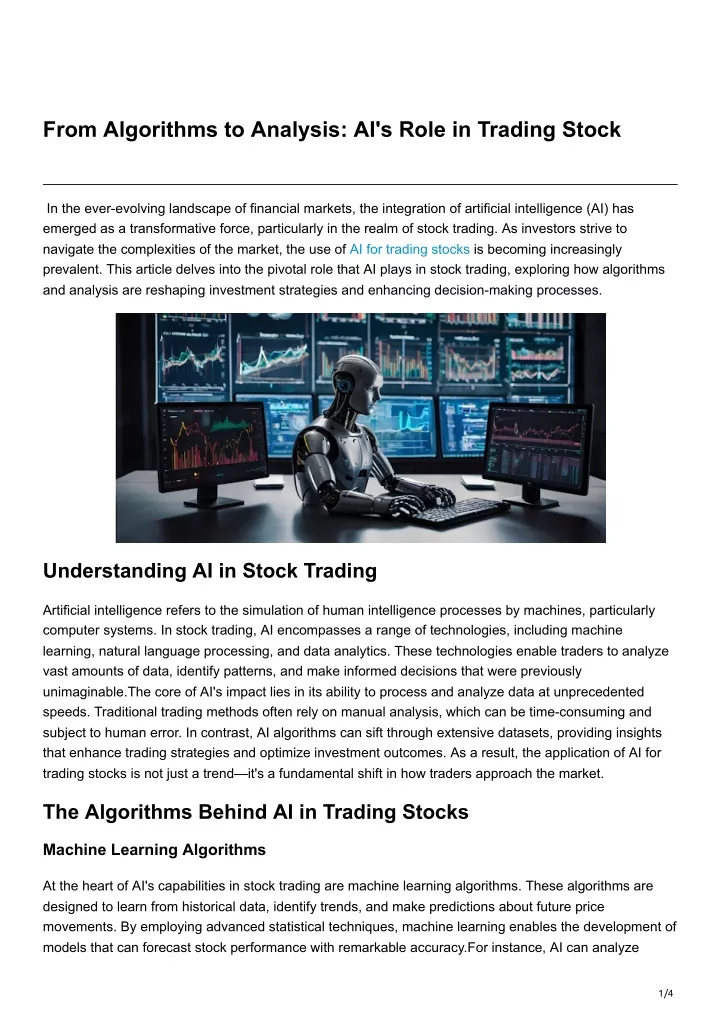20 New News For Deciding On AI Stock Investing Platform Websites
20 New News For Deciding On AI Stock Investing Platform Websites
Blog Article
Top 10 Things To Consider When Considering Ai And Machine Learning Models On Ai Trading Platforms For Stocks
To ensure accurate, reliable, actionable insights, it is crucial to examine the AI and machine-learning (ML) models utilized by prediction and trading platforms. Models that are poorly designed or overhyped can result in faulty predictions and financial losses. Here are the 10 best tips for evaluating AI/ML models for these platforms.
1. Understanding the model's goal and method of operation
The objective clarified: Identify the purpose of the model, whether it is to trade on short notice, putting money into the long term, analyzing sentiment, or managing risk.
Algorithm transparency - Check to see if there are any disclosures about the algorithms (e.g. decision trees neural nets, neural nets, reinforcement, etc.).
Customizability: Determine whether the model could be adjusted to your specific trading strategy or your risk tolerance.
2. Evaluate the Model Performance Metrics
Accuracy. Find out the model's ability to predict, but do not depend on it solely, as this can be inaccurate.
Recall and precision (or accuracy) Assess the extent to which your model is able to discern between real positives - e.g., accurately predicted price movements as well as false positives.
Risk-adjusted Returns: Determine whether a model's predictions produce profitable trades taking risk into consideration (e.g. Sharpe or Sortino ratio).
3. Check your model by backtesting it
Performance history The model is tested by using data from the past to evaluate its performance under prior market conditions.
Testing outside of sample: Make sure your model has been tested using the data it was not developed on in order to prevent overfitting.
Scenario-based analysis: This involves testing the accuracy of the model under various market conditions.
4. Be sure to check for any overfitting
Overfitting Signs: Look for models that do exceptionally well when trained but poorly with data that is not trained.
Regularization methods: Check that the platform does not overfit when using regularization methods such as L1/L2 and dropout.
Cross-validation is an essential feature and the platform must make use of cross-validation when evaluating the generalizability of the model.
5. Review Feature Engineering
Important features: Make sure that the model is based on meaningful features (e.g. price, volume and technical indicators).
Choose features carefully: The platform should only contain statistically significant information and not redundant or irrelevant ones.
Updates to features that are dynamic: Determine whether the model will be able to adjust to market changes or to new features as time passes.
6. Evaluate Model Explainability
Interpretability (clarity) It is important to check whether the model can explain its predictions in a clear manner (e.g. value of SHAP or importance of features).
Black-box model: Beware of platforms which make use of models that are overly complicated (e.g. deep neural networks) without describing the tools.
User-friendly Insights that are easy to understand: Ensure that the platform provides an actionable information in a format traders are able to easily comprehend and use.
7. Review the model Adaptability
Market fluctuations: See if your model can adapt to market shifts (e.g. new laws, economic shifts or black-swan events).
Continuous learning: Check if the platform updates the model often with fresh data to increase performance.
Feedback loops: Ensure that the platform is able to incorporate real-world feedback and user feedback to improve the system.
8. Be sure to look for Bias Fairness, Fairness and Unfairness
Data biases: Make sure that the training data are valid and free of biases.
Model bias - Determine if your platform actively monitors, and minimizes, biases within the model predictions.
Fairness: Make sure the model doesn't disadvantage or favor specific sectors, stocks or trading strategies.
9. Assess Computational Effectiveness
Speed: Evaluate if you can make predictions with the model in real-time.
Scalability: Check whether the platform can manage huge datasets and a large number of users without affecting performance.
Utilization of resources: Ensure that the model is optimized to make efficient utilization of computational resources (e.g. GPU/TPU use).
10. Transparency in Review and Accountability
Model documentation: Make sure that the model platform has detailed documentation regarding the model architecture, the training process and its limitations.
Third-party auditors: Examine whether the model has undergone an independent audit or validation by an independent third party.
Error Handling: Check if the platform has mechanisms to detect and correct any errors in models or malfunctions.
Bonus Tips
User reviews Conduct user research and research cases studies to evaluate the performance of a model in the real world.
Free trial period: Try the accuracy and predictability of the model by using a demo or a free trial.
Support for customers - Ensure that the platform you choose to use is able to provide robust support to solve problems related to model or technical issues.
These suggestions will assist you to examine the AI and machine learning algorithms used by platforms for stock prediction to make sure they are trustworthy, transparent and aligned with your goals for trading. Read the top rated ai for trading info for website info including ai investing platform, ai for investment, ai investing, trading with ai, ai stock trading bot free, investing ai, stock ai, ai stocks, market ai, ai for investing and more.
Top 10 Strategies To Maintain And Update Ai Trading Platforms
Assessing the updates and maintenance of AI-driven platforms for trading and stock prediction is crucial to ensure that they remain effective, secure and in tune with the changing market conditions. Here are 10 top tips for evaluating their updating and maintenance methods.
1. Frequency of Updates
Check the frequency of updates (e.g. every week, monthly or quarterly).
Why: Regular updates show an active and receptiveness to market changes.
2. Transparency and Release Notes
Tip: Review the platform's release notes to find out what modifications or enhancements are in the works.
Why? Transparent Release Notes demonstrate the platform’s commitment for continuous advancement.
3. AI Model Retraining Schedule
You can ask the AI model how often it is retrained.
Why? Markets evolve and models have to change to remain relevant and accurate.
4. Correction of bugs and issues
Tip - Assess the speed with which the platform resolves bugs and technical issues.
The reason: Quick corrections to bugs will ensure the platform is reliable and operational.
5. Security Updates
Tips: Make sure that the platform updates its security protocols on a regular basis to ensure the security of data of traders and users.
Why is it important: Security in financial platforms is essential to guard against breaches and fraud.
6. Integration of New Features
TIP: Check to see if the platform has introduced new functions (e.g. improved analytics, or new sources of data) in response to customer feedback or market trends.
Why are feature updates important? They show innovation and responsiveness towards the needs of users.
7. Backward Compatibility
Tips: Ensure that the updates you install do not require major reconfiguration or disrupt the functionality of your current system.
Why? Backward compatibility is important to ensure a smooth user interface during transitions.
8. User Communication During Maintenance
You can evaluate the communication of maintenance schedules and downtimes to users.
What is the reason? Clear communication prevents interruptions and increases confidence.
9. Performance Monitoring and Optimization
TIP: Find out if the platform monitors its performance indicators (e.g. latency, latency and accuracy) and then optimizes its system.
Why constant optimization is important: It ensures that the platform remains effective and expandable.
10. Compliance with Regulation Changes
Tip: See whether your platform is up-to-date with the latest technology, policies, and laws pertaining to data privacy or new financial regulations.
Why: It is important to comply with regulations to reduce legal risk and keep trust among users.
Bonus Tip: User Feedback Integration
Find out if the platform integrates active feedback from its users in its upkeep and updates procedures. This shows a user-centric approach and dedication to continuous improvement.
By evaluating these factors, you can make sure that the AI-powered stock prediction and trading platforms that you pick are regularly maintained, updated and able to adjust to market conditions that change. View the most popular ai stock trader info for website advice including chart analysis ai, free ai stock picker, can ai predict stock market, ai software stocks, investing with ai, chart ai trading, ai copyright signals, ai tools for trading, free ai stock picker, how to use ai for stock trading and more.